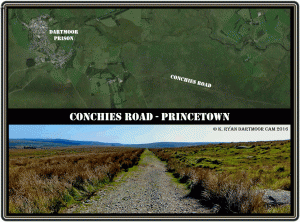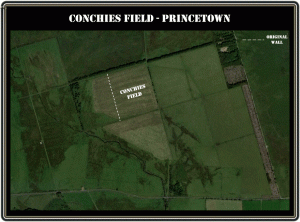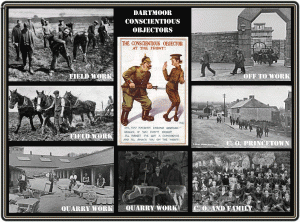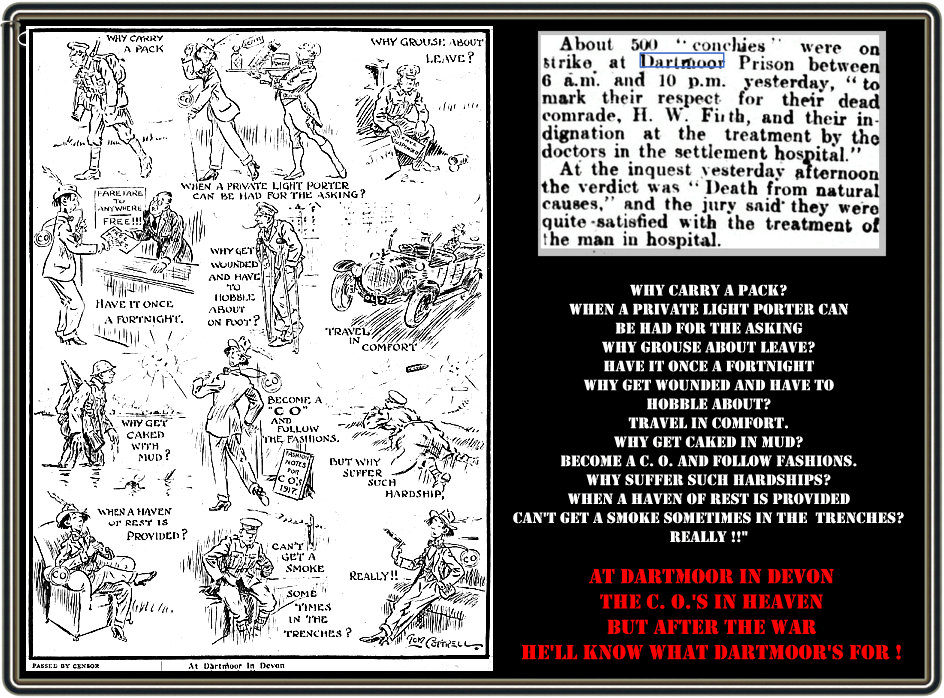
Having just written a page on Dartmoor field names one struck a chord and that was ‘Conchie’s Field‘, additionally quite recently somebody posted a picture of ‘Conchie’s Road‘ and asked why it was so called. So as it’s part of Dartmoor’s heritage I thought it may be worthwhile to give a brief history of the Conscientious Objectors of Word War One and their time spent at Dartmoor Prison. Their story is a very emotive one as some will say they were to be admired for sticking to their morals and principles whilst others will condone their behaviour as cowardly and selfish and I don’t propose to get into that debate here. What can be said is that these men have literally made their marks on the Dartmoor landscape and in its history.
Due to the enormous numbers of dead and wounded servicemen in the First World War the government in 1916 introduced ‘The Military Service Act’ which basically meant compulsory conscription to the army for men between the ages of 18 and 41. However there were some grounds for exemption amongst which were those employed in essential work and men who either for religious or moral beliefs refused to do so. Those who objected to their call-up then went before a Military Service Tribunal who would either grant exemption or refuse it, if refused there was one opportunity to appear before an Appeals Tribunal. Those who refused military service on the grounds of moral or religious beliefs were known as ‘Conscientious Objectors’ and such a person was defines as “An individual who has claimed the right to refuse to perform military service on grounds of freedom of thought, conscience and/or religion.” There were then three sub-divisions of CO’s; Absolutists – those opposed to conscription as well as war, upholders of civil liberty and the freedom of the individual. Alternativists – men who were prepared to undertake civilian work that was not under the control of the military. Finally there were the Non-combatants – men who were prepared to join the army on the proviso that they were never to be trained in the use of weapons. James, pp. 33 – 24.
In the February of 1917 the Directors of the Convict Prisons handed over the entire Dartmoor Prison to the Committee on Employment of Conscientious Objectors when it became known as the ‘Princetown Work Centre. On the 22nd of march it was confirmed in Parliament that there were 407 COs at Princetown and that other men from Warwick and Wakefield were due to be transferred there. It was also confirmed that they would be employed on the farm and in reclaiming agricultural land for which they would be paid 8d a day. It’s worth noting here that a basic serviceman’s pay at this time was 1/- (shilling) a day or in other words 4d more ???? It has been said that eventually there were around 1,000 COs sent to Princetown. Although living in the prison the men were not officially classified as ‘prisoners’ as in the eyes of the law they had not committed any offence. This meant that security in the prison prior to their arrival was very much relaxed. The locks were removed from the cell doors and the men were allowed to mix with each other and in any spare time they had it was permissible to wander around Princetown and its vicinity. Inside the prison the COs had access to a library, gymnasium and a games room and entertainment such as concerts were also held. The numbers of prison warders was greatly reduced, one report says down to a mere 50 guards. There was no prison uniform and the COs wore whatever clothes they had, this included work periods as well.
Having said all that life was still no picnic at the prison, the cells were just as bleak and cold with meagre rations often comprising of potatoes and swedes along with small amounts of meat. The poor diets meant health problems were an issue with many men suffering from boils, rashes and other conditions relating to malnutrition. Due to the poor conditions of the cells it was at times impossible for the men to dry any wet clothing which meant they often had to live in soggy and uncomfortable attire. The medical resources were limited to say the most and a couple of account s of the time serves to show how poor; “At Dartmoor we had a young fellow who died in Dartmoor. As I was working in the hospital at the time I attended him. I was a sort of orderly, you know. He was a Yorkshire boy, he was only a boy really, a chap under 21, and he was a local preacher with the Methodists up there. He had pneumonia. He’d been badly treated at Dartmoor. He should never have been sent out on the moor in the weather because he was liable to all that kind, he should have had an indoor job. The whole of the men attended the funeral. They followed behind the coffin down to the railway station and it was put on the little train at Princetown and taken down to Plymouth. And I remember those nearly a thousand men sang a hymn, Abide With Me.” Another example reads; “I was sent to dig in the garden and I did it and I went unconscious, that knocked me completely out. And then after that I was given a job of dealing with stones, stonework. And that was very difficult work to shape stones. You had to use a hammer and chisel to do that. And I was knocking on a piece of stone and one of the chips went completely into my wrist there and that was terribly painful, that was. And I had to have it taken out. And they’d got no anaesthetic or anything, they had to do the best they could with it. And I went out then, that sent me out, you see.”, Clements online source.
Just like the resident inmates before them the COs were compelled to do hard labour, this was arduous work with ten hour shifts on weekdays and six and a half hours on Saturdays. The work comprised of many tasks like quarrying as can be seen from the photograph below. It is interesting to note that these men were fashioning DPC (Dartmoor Convict Prison) boundstones. They were also set to road building and today their handywork can be seen in what has been called the ‘Road to Nowhere‘. More commonly known as the ‘Conchies Road‘ this track ran from Bullpark and made its way in a south easterly direction towards the river Swincombe. The road is clearly visible on an aerial photograph and is still used today by many walkers. Another task set before the COs was land reclamation which meant draining the boggy land in order for it to be fit for agricultural purposes. To this very day an enclosure north of the prison is known as the ‘Conchies Field‘ although the original enclosure has been enlarged by combining it with its neighbour. General farm work was also on the daily agenda as at that time the prison farm was fully functional. A couple of years ago I bought a CD Rom with hundreds of old Dartmoor photographs on it, amongst which were some of COs at Princetown as can be seen below.
The Conscientious Objectors were common sights in and around Princetown which caused a great deal of resentment amongst its residents. At that time many local men were fighting in the trenches and to see the COs safely working and wandering around the town added fuel to the fire. It must have been especially upsetting for those whose husbands, sons, brothers, relatives or friends had been killed or injured during the conflicts. Additionally many of the prison warders were men who had previously seen military service and never looked kindly on the COs, often subjecting them to abuse and utter contempt. At the time it was said that when compared to the dangers and hardships faced by the men fighting abroad the COs were having an easy life at Princetown. Some newspapers were calling them ‘Princetown’s Pampered Pets‘ and ‘The Coddled Conscience Men‘ which when mixed with the patriotic ferver of the time added greater hatred towards them. One local newspaper published the following account; “The COs at Princetown are still a source of disgust to the local inhabitants. Their general behaviour is such that the people wish they were further away. At a Wesleyan chapel one Sunday “an excited gentleman stood in the gangway and loudly sang a verse of the National Anthem and added a line or two of his own strafing the COs and consigning them to a very warm place.” The article also mentioned that six COs had been returned to the military for various offences. Even the then time Bishop of Exeter had words to say when in a letter to the times he described the prison as being; “a hotbed of malcontents.” Redgrave, p.10 – 11. In the July of 1917 a crowded protest meeting was held at Plymouth Guildhall. The resolution put forward expressed; “a strong resentment at the liberties and privileges allowed to the ‘law breakers’ at Princetown.” It was also suggested that; “unless these persons were confined within the grounds of the prison there would be serious consequences.” Alderman Woollcombe who moved the resolution further added that; “it was a scandal that these men should be allowed to live pretty much as they please and buy what food they fancied. None of these men were Conscientious Objectors within the meaning of the Military Service Acts. They were disloyal men, anarchists, and preachers of a bastard socialism. They had rations on a higher scale than the Food Controller laid down for the civil population and they bought as much food as they liked.” Times Newspaper 26th April 1917.
In ‘The Bystander’ of 1917 featured the cartoon below with the title; “The Soldier and the C. O. – A Study in Treatment” which reflects the mood of the times and it’s worth noting that it had been ‘passed by censor’. Probably the most poignant aspect of this cartoon are the lines; “At Dartmoor in Devon, the C. O.’s in heaven, But after the war, He’ll know what Dartmoor’s for !”
It was never the case that all the COs were what could be described as ‘model prisoners’, amongst their numbers were some with strong political allegiances to such as the Communist Party. There were also those who considered themselves as intellectuals and considered their treatment as unjust and against their civil liberties. So not surprisingly there was a strong feeling of resentment amongst these men which turned many of them into agitators and troublemakers. This manifested itself in many ways, one example being the interruption of church services when instead of singing the National Anthem some would sing the Red Flag anthem of the Communist Party., James, p.37. Eventually the troubles and strife of life at Princetown came to an end and once the war was over they were allowed to return home. In some cases the hardships continued with further abuse from their local communities and in some cases their original jobs were never returned to them for what they had done.
There you have it, a brief outline of the Conchies of Princetown, if you would like to wander down the ‘Road to Nowhere‘ it makes for an enjoyable stroll down to the river Swincombe. Likewise should you be driving up to Omen Beam cast am eye over the wall to the west and there will be ‘Conchies Field’ possibly with livestock contentedly grazing on the pasture created by the COs of Princetown.

James, T. 2014. About Dartmoor Prison. Redruth: Orchard Publications.
Clements, K. 2016 Conscientious Objectors. Imperial War Museum Online source – HERE
Redgrave, B. 1992. Conscientious Objectors on Dartmoor – The Dartmoor Magazine – No. 28. Brixham: Quay Publications.
 Legendary Dartmoor The many aspects past and present of Dartmoor
Legendary Dartmoor The many aspects past and present of Dartmoor





Hello Tim
In the Dartmoor News magazine we are running a series about the Dartmoor Conchies and will be publishing a book next year on the subject, readers may be interested.
All the best
Paul
Hi Tim,
Have just come across and read your fascinating article on Conscientious Objectors which has prompted me to write.
I am particularly interested in the PCWW stones which Plymouth Corporation erected around the Burrator rainwater catchment area in 1917, and have undertaken some research but there is not much information available.
I have always felt that it was a strange time to be undertaking works like this, in the midst of a war, but it seems from your article that there was a lot of free labour available in 1917.
I was therefore wondering if in your research for this article you came across anything which even hinted that these COs may have been involved with erecting some 50+ granite PCWW stones?
Any information you have and are happy to share, would be much appreciated
Hi, sadly I have come across no mention of a connection between the PCWW stones and the ‘conchies’, but maybe somebody reading this will know the answer.
Thank you for a very informative and interesting article.
Thank you Tim for this very interesting article on Dartmoor’s CO’s. I run a WW1 creative writing unit at City College Plymouth and it is stories like these that help to humanise a terrible war that can otherwise be lost under facts and figures.
Just come across this article. Very interesting to me as my grandfather was one of the CO’s sent to Dartmoor. He married my grandmother in Princetown in August 1918 whilst there. Both were from Leicester